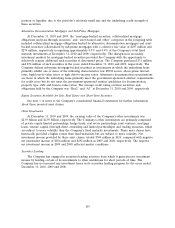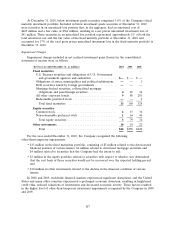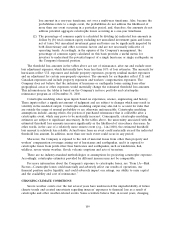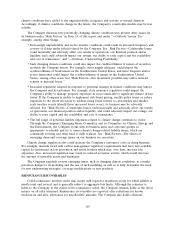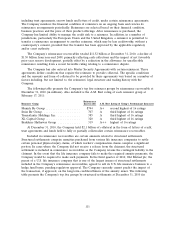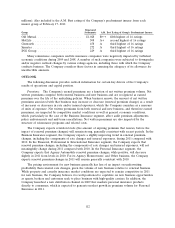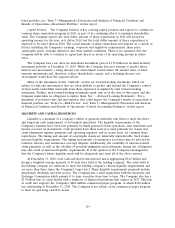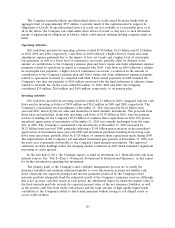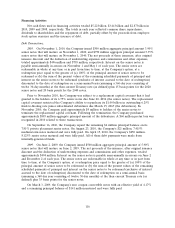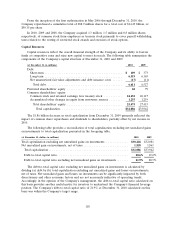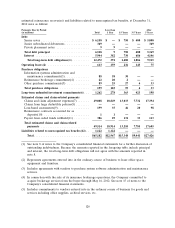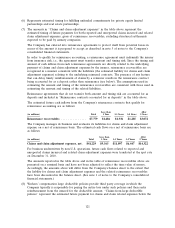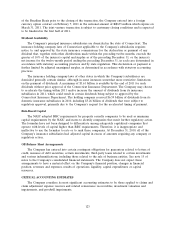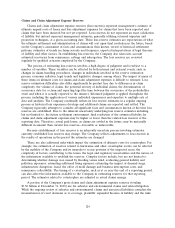Travelers 2010 Annual Report Download - page 126
Download and view the complete annual report
Please find page 126 of the 2010 Travelers annual report below. You can navigate through the pages in the report by either clicking on the pages listed below, or by using the keyword search tool below to find specific information within the annual report.bond portfolio, see ‘‘Item 7—Management’s Discussion and Analysis of Financial Condition and
Results of Operations—Investment Portfolio’’ in this report.
Capital Position. The Company believes it has a strong capital position and expects to continue its
common share repurchase program in 2011 as part of its continuing efforts to maximize shareholder
value. The Company expects the total dollar amount of share repurchases in 2011 will exceed its
operating income for the year, as it did in 2010, but the total dollar amount of share repurchases is
expected to be lower than in 2010. The actual amount of share repurchases will depend on a variety of
factors, including the Company’s earnings, corporate and regulatory requirements, share price,
catastrophe losses, strategic initiatives and other market conditions. There is no assurance that the
Company will be able to continue to repurchase shares in excess of its operating income in future
years.
The Company had a net after-tax unrealized investment gain of $1.74 billion in its fixed maturity
investment portfolio at December 31, 2010. While the Company does not attempt to predict future
interest rate movements, a rising interest rate environment would reduce the market value of fixed
maturity investments and, therefore, reduce shareholders’ equity, and a declining interest rate
environment would have the opposite effects.
Many of the statements in this ‘‘Outlook’’ section are forward-looking statements, which are
subject to risks and uncertainties that are often difficult to predict and beyond the Company’s control.
Actual results could differ materially from those expressed or implied by such forward-looking
statements. Further, such forward-looking statements speak only as of the date of this report and the
Company undertakes no obligation to update them. See ‘‘—Forward Looking Statements.’’ For a
discussion of potential risks and uncertainties that could impact the Company’s results of operations or
financial position, see ‘‘Item 1A—Risk Factors’’ and ‘‘Item 7—Management’s Discussion and Analysis
of Financial Condition and Results of Operations—Critical Accounting Estimates’’ in this report.
LIQUIDITY AND CAPITAL RESOURCES
Liquidity is a measure of a company’s ability to generate sufficient cash flows to meet the short-
and long-term cash requirements of its business operations. The liquidity requirements of the
Company’s business have been met primarily by funds generated from operations, asset maturities and
income received on investments. Cash provided from these sources is used primarily for claims and
claim adjustment expense payments and operating expenses, and in recent years, for common share
repurchases. The timing and amount of catastrophe claims are inherently unpredictable. Such claims
increase liquidity requirements. The timing and amount of reinsurance recoveries may be affected by
reinsurer solvency and reinsurance coverage disputes. Additionally, the variability of asbestos-related
claim payments, as well as the volatility of potential judgments and settlements arising out of litigation,
may also result in increased liquidity requirements. It is the opinion of the Company’s management
that the Company’s future liquidity needs will be adequately met from all of the above sources.
At December 31, 2010, total cash and short-term invested assets aggregating $3.61 billion and
having a weighted average maturity of 58 days were held at the holding company. The assets held at
the holding company are sufficient to meet the holding company’s current liquidity requirements and
are more than three times the Company’s target level. These liquidity requirements primarily include
shareholder dividends and debt service. The Company has a shelf registration with the Securities and
Exchange Commission which permits it to issue securities from time to time. The Company also has a
$1.0 billion line of credit facility with a syndicate of financial institutions that expires in 2013. This line
of credit also supports the Company’s $800 million commercial paper program, of which $100 million
was outstanding at December 31, 2010. The Company is not reliant on its commercial paper program
to meet its operating cash flow needs.
114



